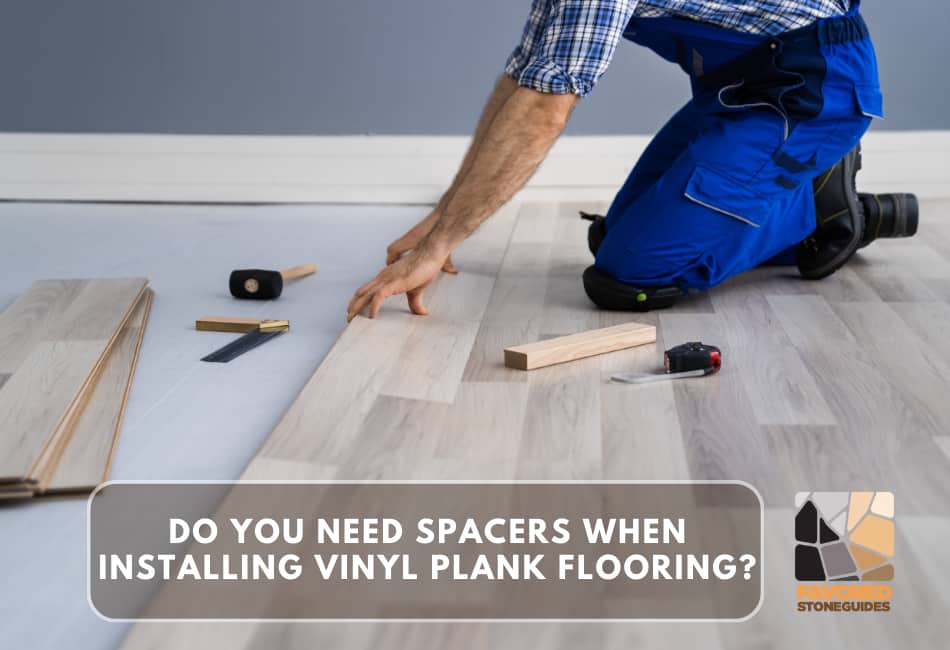Installing vinyl plank flooring is a popular choice for DIY enthusiasts due to its simplicity, durability, and appealing aesthetics.
A correctly installed floor ensures longevity, maintains the beauty of your space, and can significantly enhance the value of your home.
However, one question often arises during the installation process: “Do you need spacers when installing vinyl plank flooring?”
In the following sections, we will delve into the specifics of vinyl plank flooring installation, the role of spacers, and how they contribute to the overall outcome of your flooring project.
Expansion Gaps and Spacers
What are Expansion Gaps?
Let me take you back to my first DIY flooring project. I was as excited as a kid in a candy shop, but little did I know about the importance of leaving expansion gaps.
Expansion gaps are the small spaces left around the room’s perimeter, and they serve a crucial role.
Due to the natural properties of vinyl material, it can expand and contract with temperature fluctuations.
Without these gaps, the floor could buckle or warp, leaving you with a less-than-perfect finish and potential damage.
The Role of Spacers
Which brings us to the role of spacers. Remember that first DIY project I mentioned? Well, it didn’t entirely turn out as expected.
I didn’t use spacers, and my floor looked more like a roller coaster than a smooth surface.
That’s when I learned the hard way – spacers are your best friends when installing vinyl plank flooring.
They help maintain consistent expansion gaps around the edges of your floor during installation.
Once the floor is laid, the spacers are removed, leaving the perfect amount of space for natural expansion and contraction.
So, do you need spacers when installing vinyl plank flooring? Based on my experience, absolutely yes!
The Importance of Expansion Gaps
Let’s dive deeper into why these tiny gaps are essential when installing vinyl plank flooring.
Potential Issues Without Expansion Gaps
My excitement to finish the job led me to skip a crucial step – leaving sufficient expansion gaps.
The result? My beautiful new floor buckled and warped like a wooden roller coaster.
This was a classic case of thermal expansion – the vinyl planks had expanded due to warmer temperatures but had nowhere to go due to the lack of expansion gaps.
They were forced to push against each other, creating an unsightly and uneven floor.
Accommodating Temperature and Humidity Fluctuations
Vinyl, like many materials, is sensitive to temperature and humidity changes.
As the environment gets warmer, vinyl expands, and it contracts when things cool down. This is where the magic of expansion gaps comes into play.
By leaving a small space around the room’s edges, you give the vinyl planks room to breathe, expand, and contract without causing any damage.
Think of it like a stress relief system for your floor.
From the sweltering heat of summer to the icy chill of winter, the expansion gaps ensure your vinyl plank floor maintains its integrity and appearance.
Trust me, your floor (and wallet) will thank you for it!
Types of Vinyl Plank Flooring Installation
As you venture into the world of vinyl plank flooring installation, you’ll encounter two popular methods: “Floating” and “Glue-Down.” Let’s explore each one in more detail:
Floating Vinyl Plank Floors
The floorboards are designed to interlock with each other, forming a single unified layer that “floats” over the subfloor.
No adhesives, no nails, snap and lock, and voila, you have a new floor!
The floating method gives you some wiggle room (pun intended) for expansion and contraction.
Plus, it’s easier to remove or replace if a plank gets damaged. My favorite part? It’s a breeze to install! Just make sure you leave those essential expansion gaps.
Glue-Down Vinyl Plank Floors
Gluing down the vinyl plank floors was a bit more challenging but was worth every bit of the effort.
With the glue-down method, each plank is adhered to the subfloor using a unique adhesive.
It’s a more permanent solution and can handle heavy foot traffic like a champ!
The glue-down method offered me an incredibly stable and sturdy floor.
But remember, with excellent permanency comes great responsibility – precise measurements and careful installations are key.
Don’t forget those expansion gaps; otherwise, you might end up with another “Flooring Fiasco of ’98” on your hands.
Spacers in Floating Installation
I can’t emphasize the importance of spacers in a floating vinyl plank installation. Spacers are your best friends here.
They maintain the necessary expansion gaps around the periphery of your room, ensuring your floor has enough room to expand and contract with temperature fluctuations.
The golden rule? Always maintain a gap of 1/4 inch to 3/8 inch between the planks and walls. You wouldn’t want your floor buckling up in the middle now, would you?
Spacers in Glue-Down Installation
Do we need spacers in glue-down installations, you ask?
Well, here’s the thing – adhesive and trowel size play a significant role in determining this.
While it’s not inherently necessary to use spacers, they can help maintain consistent gaps when applying the adhesive.
However, as the floor is glued down, it doesn’t have the same allowance for expansion, and the space requirements aren’t as stringent.
When Spacers Aren’t Necessary
A question I often get asked is, “When can we do without spacers?”
While specific scenarios might not require spacers, like a small closet floor or a tiny bathroom, it’s always safest to follow the manufacturer’s guidelines.
Tips for a Successful Vinyl Plank Flooring Installation
Now, let’s talk about some practical tips for a successful installation.
First, acclimatize your flooring to the room temperature and humidity conditions for at least 48 hours before installation.
Then, ensure your subfloor is clean, level, and dry. A tapping block and rubber mallet are your best buddies for getting snug fits between planks. Trust me, your knees and your floor will thank you!
Common Mistakes to Avoid
Finally, let’s talk about avoiding common mistakes. Remember our golden rule of maintaining expansion gaps?
Don’t let anything encroach on those expansion spaces – not cabinets, not islands, nothing!
Also, never use a hammer directly on the planks; always use a tapping block.
And please, for the love of solid, beautiful floors, don’t ignore the manufacturer’s instructions!
Conclusion
Let’s wrap up our vinyl planking journey here, folks. So, after diving deep into the topic, the central question comes back:
“Do you need spacers when installing vinyl plank flooring?” In my years of experience, I’d say a resounding “yes!”
Spacers help maintain those all-important consistent gaps during adhesive application.
Just remember, every situation may not require them. For instance, a tiny closet or small bathroom might give you a pass.
But, as I always tell my crew, it’s better to err on caution.
We’ve covered much today, from allowing your flooring to acclimate to room conditions to keeping that subfloor clean and dry.
And, of course, never forget your handy dandy tapping block and rubber mallet.
They’ll save your knees and ensure snug fits between planks.
Lastly, don’t ignore the manufacturer’s instructions. I cannot stress this enough.
The guidelines are there for a reason, folks, and trust me, taking shortcuts doesn’t end well.
I’ve been down that road, and let me tell you, it’s not a fun journey.
So, make informed decisions and ensure a successful vinyl plank flooring installation.
Remember, your floor isn’t just a surface to walk on—it’s an investment in your home and a reflection of your style. Make it count!

